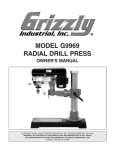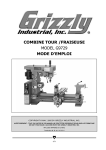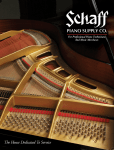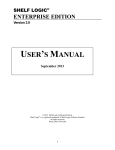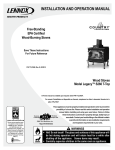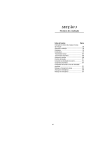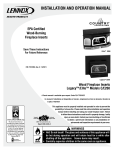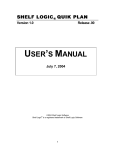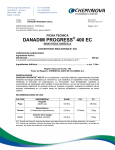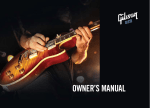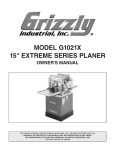Download Grizzly H6083 Musical Instrument User Manual
Transcript
HEIRLOOM GUITAR KITS MODELS H6082, H6083, H6086 INSTRUCTION MANUAL COPYRIGHT © MAY, 2004 BY GRIZZLY INDUSTRIAL, INC. REVISED JANUARY, 2007 (BL) WARNING: NO PORTION OF THIS MANUAL MAY BE REPRODUCED IN ANY SHAPE OR FORM WITHOUT THE WRITTEN APPROVAL OF GRIZZLY INDUSTRIAL, INC. #EW6299 PRINTED IN KOREA WARNING Some dust created by power sanding, sawing, grinding, drilling, and other construction activities contains chemicals known to the State of California to cause cancer, birth defects or other reproductive harm. Some examples of these chemicals are: • Lead from lead-based paints. • Crystalline silica from bricks, cement, and other masonry products. • Arsenic and chromium from chemically treated lumber. Your risk from these exposures varies, depending on how often you do this type of work. To reduce your exposure to these chemicals: work in a well ventilated area, and work with approved safety equipment, such as those dust masks that are specially designed to filter out microscopic particles. Table of Contents SECTION 1: SAFETY ....................................................................................................................... 2 SECTION 2: INTRODUCTION ......................................................................................................... 3 Foreword .................................................................................................................................... 3 Contact Info ................................................................................................................................ 3 SECTION 3: PARTS INVENTORY ................................................................................................... 4 Model H6082/3 Parts ................................................................................................................. 4 Model H6086 Parts .................................................................................................................... 5 Supplies/Tools ............................................................................................................................ 6 Identification ............................................................................................................................... 6 SECTION 4: ASSEMBLY ................................................................................................................. 7 Shaping the Headstock on Model H6082/83 ............................................................................. 7 Sanding the Body ....................................................................................................................... 8 Sanding the Neck ....................................................................................................................... 8 Finishing the Neck...................................................................................................................... 9 Finishing the Body.................................................................................................................... 10 Installing the Tuners ................................................................................................................. 11 Installing the Neck .................................................................................................................... 12 Installing the Pickups ............................................................................................................... 13 Wiring the Pickups ................................................................................................................... 14 Audio Jack ................................................................................................................................ 15 Strap Buttons ........................................................................................................................... 15 Installing Bridge on Model H6082/83 ....................................................................................... 16 Installing Bridge on Model H6086 ............................................................................................ 17 Mounting Back Plates .............................................................................................................. 18 Gluing the Nut on the Model H6082 and H6083...................................................................... 18 Attaching the Nut on the Model H6086 .................................................................................... 19 Truss Rod Cover ...................................................................................................................... 19 Winding Strings on Model H6082/83 ....................................................................................... 20 Winding Strings on the Model H6086 ...................................................................................... 21 SECTION 5: SET UP ...................................................................................................................... 22 General..................................................................................................................................... 22 Neck Adjustment ...................................................................................................................... 22 String Height Adjustment for Model H6082/83 ........................................................................ 23 String Height Adjustment for the Model H6086 ....................................................................... 24 Pickup Adjustments .................................................................................................................. 25 Spring Adjustment On the Model H6086 ................................................................................. 26 Tuning ...................................................................................................................................... 26 Setting Intonation ..................................................................................................................... 27 SECTION 6: REFERENCE INFO ................................................................................................... 28 Accessories .............................................................................................................................. 28 Warranty & Returns.................................................................................................................. 30 Warranty Card .......................................................................................................................... 31 Model H6082, H6083, and H6086 Heirloom Electric Guitar Kits -1- SECTION 1: SAFETY Always wear safety glasses or goggles when operating equipment. Everyday glasses or reading glasses are not safety glasses. Be certain the safety glasses you wear meet the appropriate standards of the American National Standards Institute (ANSI). Because there are various ways to cut and join wood, you can make substitutions for the methods stated in this manual. We try to suggest the easiest methods possible. However, only you know your skills with each piece of machinery. Never compromise your safety by using a cutting method with which you are not comfortable. Instead, find an alternative approach that will yield the same result. These instructions assume that you are intimately familiar with the safe operation and use of woodworking machinery and woodworking tools, and understand the techniques used to assemble this project. If you do not qualify for both of these criteria, STOP building this project for your own safety. Read and understand the owners manual for the machinery you intend to use, take a woodworking class or visit your local library for more information. Woodworking machinery and tools are inherently dangerous because they use sharp edges that can and will cause serious personal injury including amputation and death. Do not underestimate the ability of these tools and machinery to cause injury. Never operate any tool without all guards in place and always wear approved safety glasses. For your own safety, please heed this warning. -2- Model H6082, H6083, and H6086 Heirloom Electric Guitar Kits SECTION 2: INTRODUCTION Foreword Contact Info We are proud to offer the Heirloom Electric Guitar Kits. These kits are a part of a growing Grizzly family of fine woodworking products. When assembled according to the guidelines set forth in this manual, you can expect years of enjoyment from your guitar. If you have any comments regarding this manual, please write to us at the address below: We are pleased to provide this manual for the Model H6082, H6083 and the H6086 Heirloom Electric Guitar Kits. It was written to guide you through assembly, review safety considerations, and cover general information. It represents our effort to produce the best documentation possible. Grizzly Industrial, Inc. /O Technical Documentation P.O. Box 2069 Bellingham, WA 98227-2069 C Most importantly, we stand behind our products. If you have any questions or parts requests, please call or write us at the location listed below. Grizzly Industrial, Inc. 1203 Lycoming Mall Circle Muncy, PA 17756 Phone: (570) 546-9663 Fax: (800) 438-5901 E-mail: [email protected] Web Site: http://www.grizzly.com The specifications, drawings, and photographs illustrated in this manual represent the Model H6082, H6083 and H6086 Heirloom Electric Guitar Kits as supplied when the manual was prepared. However, owing to Grizzly’s policy of continuous improvement, changes may be made at any time with no obligation on the part of Grizzly. For your convenience, we always keep current Grizzly manuals available on our website at www.grizzly.com. Any updates to products will be reflected in these manuals as soon as they are complete. Visit our site often to check for the latest updates to this manual! Model H6082, H6083, and H6086 Heirloom Electric Guitar Kits -3- SECTION 3: PARTS INVENTORY Model H6082/3 Parts REF 1 2 2 3 4 5 6 7 8 9 10 11 12 13 14 15 16 17 18 19 20 21 22 23 24 PART # PH6082001 PH6082002 PH6083002 PH6082003 PH6082004 PH6082005 PH6082006 PH6082007 PH6082008 PH6082009 PH6082010 PH6082011 PH6082012 PH6082013 PH6082014 PH6082015 PH6082016 PH6082017 PH6082018 PH6082019 PH6082020 PH6082021 PAW04M PH6082023 PH6082024 5 DESCRIPTION Neck 1 Guitar Body for H6082 1 Guitar Body for H6083 1 Pickups 2 Tuners with Screws 6 Tuner Bushings with Washers 6 Truss Rod Cover w/Screws 1 Wiring Harness 1 Strings 6 Tap Screws M2 X 12 9 Tap Screws M5 X 45 10 Tap Screws M3 X 12 14 Audio Jack Nuts w/Washers 2 Control Knob Nuts w/Washers 3 Control Knobs 2 Audio Jack Nuts w/Washers 2 Tailstop 1 Bridge 1 Bridge Adjusting Assembly 2 Tailstop Adjusting Assembly 2 Control Cavity Cover Plate 1 Strap Buttons w/Screws 2 Hex Wrench 4mm 1 Nut 1 Audio Jack Plate 1 4 6 Figure 2. H6082/3 peghead components. 9 7 8 15 10 14 11 Figure 3. H6082/3 guitar parts. 17 16 1 12 13 18 20 19 2 21 24 3 23 22 Figure 4. H6082/3 more guitar parts. Figure 1. H6082/3 boxed components. -4- Model H6082, H6083, and H6086 Heirloom Electric Guitar Kits Model H6086 Parts REF 1 2 3 4 5 6 7 8 9 10 11 12 13 14 15 16 17 18 19 20 21 22 23 PART # PH6086001 PH6086002 PH6086003 PH6086004 PH6086005 PH6086006 PH6086007 PH6086008 PH6086009 PH6086010 PH6086011 PH6086012 PH6086013 PH6086014 PH6086015 PAW04M PH6086017 PH6086018 PH6086019 PH6086020 PH6086021 PH6086022 PH6086023 5 DESCRIPTION Neck 1 Guitar Body 1 Pickups 2 Strings 6 Tuners w/Bushings and Washers 6 Truss Rod Cover w/Screws 1 Strap Buttons w/Screws 1 Floyd Rose Locking Nut 1 Floyd Rose Bridge 1 Control Cavity Cover Plate 1 Tremolo Bar 1 Adjustable Bridge Insert 2 Tremolo Spring 4 Spring Claw w/Tap Screws 1 Tap Screws M3 X 12 18 Hex Wrench 4mm 1 Wiring Harness 2 Control Knobs 6 Control Knob Nuts w/Washers 2 Audio Jack Nuts w/Washers 1 Tap Screws M2 X 12 9 Tap Screws M2.6 X 16 1 Audio Jack Plate 10 4 8 6 7 Figure 6. H6086 peghead components. 9 13 10 12 11 14 Figure 7. H6086 bridge parts. 17 16 1 15 2 18 20 22 3 23 21 19 Figure 8. H6086 guitar parts. Figure 5. H6086 boxed components. Model H6082, H6083, and H6086 Heirloom Electric Guitar Kits -5- Supplies/Tools Identification The majority of the wooden components in this kit are fully machined from the factory and are ready for assembly. A small amount of shaping, drilling, sanding and finishing will need to be performed to complete your guitar. Recommended Tools & Supplies: • • • • • • • • • • • • • • • • • • • • • • • • • • • • • Sharp Pencil 18" Metal Straightedge with a 1⁄ 32" Resolution Drill Press Drill Bits: 1⁄ 16", 3 ⁄ 32", 1⁄ 8", 5 ⁄ 32", 3 ⁄ 16", 5 ⁄ 16" Depth Stop Bandsaw or Coping Saw with 1⁄4" Blade ANSI Approved Respirator ANSI Approved Safety Glasses Aluminum-Oxide Sanding Paper #150, #220, and #320 Grit Wet and Dry Sanding Paper #400, #600, and #1000 Grit Flexible Sanding Block Wood Glue Chisel or Razor Blade Phillips Screwdriver 1 ⁄4" Steel Rod, or a Coat Hanger Masking Tape Tack Cloth or Clean Soft Rag Sanding Sealer Assorted Wood Files Finishing Materials Buffing Compounds Oil Wood Finish Soldering Iron and Solder Peghead Reamer or a Round File Ratchet with 11MM and 14MM Sockets Hammer Small Wooden Block C-Clamps Wire Cutters Strap Button Bridge Pickups Tone Controls Volume Controls 3-Way Switch Tremolo Bar Figure 9. Model H6086 identification. Tailstop Bridge Pickups Strap Button Tone Controls Volume Controls 3-Way Switch Figure 10. Model H6082/3 identification. Fretboard Nut Peghead Truss Rod Cover Fret Tuners Figure 11. Peghead identification. -6- Model H6082, H6083, and H6086 Heirloom Electric Guitar Kits SECTION 4: ASSEMBLY Shaping the Headstock on Model H6082/83 The peghead for these models comes as a large square so it can be cut to any shape. The only limitation is the strength of the wood. If the headstock is cut too close to the pegholes or in between the pegholes and the nut, the wood may crack under the pressure of the strings. These instructions will guide you through designing the shape of the headstock and the placement of the pegholes. Components Needed Qty Guitar Neck ....................................................... 1 Tools Needed Sharp Pencil ......................................................1 Paper ........................................................ Varies Bandsaw with a 1⁄4" Blade or a Coping Saw .....1 Woodworking Files ................................ Assorted Drill Press with a 3⁄8" Drill Bit...............................1 4. Layout the tuners on the test piece to ensure you have enough room between the tuners and for the tuner buttons to turn. 5. Redraw your final headstock shape onto the headstock with a pencil. 6. Cut the headstock out with a bandsaw or coping saw. Be sure to cut to the outside edge of your pencil line. Note—To cut sharp corners, cut several slots perpendicular to the corner, then cut out the small pieces. This will reduce binding on the blade. 7. Carefully hand file the headstock to finalize the shape. 8. Drill the pegholes with a 3⁄8" drill bit in a drill press as shown in Figure 12. The pegholes are drilled slightly undersized so that the tuners will fit tight. To shape the headstock: 1. Trace the headstock onto a piece of paper. Test various ideas for headstock shapes on paper before cutting into the headstock. To design a symmetrical headstock, fold the paper in half and cut out trial shapes. 2. Layout pegholes for the tuners that are a minimum of 1⁄2" from the edge of the headstock. Space the centers of the pegholes at least 15⁄16" apart. 3. Draw the path of the strings onto the test paper to ensure that the strings do not interfere with each other. Note—If the strings cross the nut at a sharp angle, this increases friction and makes tuning difficult. It also increases the likelihood of the strings pulling out of the nut slots. Model H6082, H6083, and H6086 Heirloom Electric Guitar Kits Figure 12. Drilling the pegholes. -7- Sanding the Body The guitar body has been rough sanded at the factory, but it is up to you to do the final sanding before the finish is applied. To get a good finish the body should be sanded with a series of sandpaper grits up to #320 grit. 6. Apply a coat of sanding sealer according to the manufacturer's instructions or apply primer if you are using a solid color. Note—Make sure the sealer you are using is compatible with the finish that you plan to use. 7. When the sanding sealer or primer is dry, use #320 grit sandpaper for final sanding. DO NOT sand through to bare wood. Components Needed Qty Guitar Body ....................................................... 1 Tools Needed Flexible Sanding Block .......................................1 Aluminum-Oxide Sanding Paper #150, #220, and #320 Grit ............... Varies Sanding Sealer .......................................... Varies To sand the guitar body: 1. Wear an ANSI-approved respirator and safety glasses when sanding wood! 2. Use a flexible sanding block with #150 grit aluminum-oxide sanding paper to sand the guitar body until there is a consistent scratch pattern on the entire surface. Note—When hand sanding, always sand in the same direction as the wood grain. 3. Resand the entire guitar body with #220 grit sanding paper and lightly round over the outside edges of the body. DO NOT round over the neck pocket or the body cavities. 4. Wipe the guitar body with a damp cloth to “raise” the wood grain, allowing the “raised” grain to be sanded smooth. 5. Wait until the wood is dry and resand the entire body with #220 grit sandpaper. Dampen again and resand. Note—If you want to add color to a natural wood finish, the stain should be applied before continuing with the next step. Stains cannot be applied to the guitar body after the sanding sealer. -8- Sanding the Neck Like the guitar body, the guitar neck has been rough sanded at the factory. Final sanding should be done as described in the previous sub-section "Sanding the Body". Consider applying inlays or additional design work on the fretboard and headstock before final sanding. Note—Take your time and test your designs in scrap wood before performing the work on the instrument. The fretboard requires no sanding. Sanding the fretboard will affect the playability of the guitar and could lead to unrepairable damage. Model H6082, H6083, and H6086 Heirloom Electric Guitar Kits Finishing the Neck Most finishes can be hazardous to your health. Wear a NIOSH/OSHA approved respirator with particulate and gas/vapor filters, safety glasses, rubber gloves, and work in a well ventilated area when using finishing materials! Some of the finishing options include stains, lacquers, varnishes and oil finishes. Traditionally this style of guitar has a clear finish on the neck. Depending on the type of finish, they can be applied with a spray gun, brush, rag, or a spray can. Finish materials and books on finishing instruments can be ordered through Grizzly Industrial or numerous luthier supply catalogs. Components Needed Qty Guitar Neck ....................................................... 1 Tools Needed Masking Tape ............................................ Varies 1 ⁄4" Steel Rod, or a Coat Hanger ........................1 Tack Cloth or a Clean Rag ........................ Varies Finish and Tools for Application ................ Varies Narrow Chisel or Razor Blade............................1 Wet/Dry Sandpaper #600, #1000 grit........ Varies Buffing Materials ........................................ Varies 5. Apply the finish according to "Finishing the Body"; steps 5–11 on page 10. 6. Before wet sanding, remove the masking tape from the fretboard and carefully scrape any excess finish off the fretboard with a razor blade or chisel as shown in Figure 13. To finish the guitar neck: 1. Mask off the surface of the fretboard. Carefully press all the masking tape edges securely to the fretboard. The finish coat can seep under these edges, especially near corners, uneven edges, and places where the frets meet the fingerboard. 2. Make an "S" shaped hook out of 1⁄4" steel rod, or a coat hanger that has been folded in half. 3. Wipe the entire neck with a tack cloth or a soft clean rag to remove any dust. 4. Thread the hook through the upper peghole and hang the neck in the finish room. Figure 13. Scraping the fretboard. 7. Use a clean rag to wipe wood finishing oil on the surface of the fretboard. Model H6082, H6083, and H6086 Heirloom Electric Guitar Kits -9- Finishing the Body These guitars look incredible with a clear finish to highlight the pattern of the maple tops. The surface can be stained prior to finishing or a transparent pigment can be added to the finish. These instructions will guide you through a very basic finishing process. Books describing different guitar finishing techniques are available through luthier supply catalogs, or through your local library. Clear finish materials and books on finishing can be ordered through Grizzly Industrial. Finishing a guitar is a difficult task. If you are unsure of your skills; do your research, practice on scrap wood, or take it to a professional. Components Needed Qty Guitar Body ....................................................... 1 Tools Needed Temporary Wood Handle ...................................1 Masking Tape ............................................ Varies Tack Cloth or a Clean Rag ........................ Varies Finish and Tools for Application ................ Varies Wet/Dry Sandpaper #600, #1000 grit........ Varies Buffing Supplies ........................................ Varies To finish the guitar body: 1. 2. Mask off the neck pocket. Press the masking tape tight against the edges of the pocket so the finish does not seep under the tape. Screw through the neck pocket screw holes into a long piece of wood to use for a handle during spraying. Drill a hole in the end of the handle for hanging from a hook. 3. Wipe the entire guitar body with a tack cloth or a soft clean rag to remove any dust. 4. Thread the hook through the temporary handle and hang the body in the finish room. 5. Apply several thin coats of the finish, following the manufacturers instructions. Multiple thin coats usually produce a better quality finish than one heavy coat. -10- 6. Sand the entire body with #400 grit wet and dry sandpaper after at least three coats of finish have been applied. DO NOT sand through the finish—be especially careful on the edges. 7. Apply more finish, sanding between coats, until the finish is the desired thickness. Note—If finishing with a solid color, you may wish to apply several coats of a clear finish over the top, sanding between coats, to add depth to the finish. 9. When the final coat has dried at least a week, preferably a month, remove the temporary handle and masking. 10. Wet sand the finish using #600 grit wet and dry sandpaper on a sanding block, followed with #1000 grit wet and dry sandpaper. 11. Buff the finish by hand or with a buffer, starting with a medium polish and work up to a high gloss polish. Note—If using a buffing machine, be extremely careful to avoid going through the finish, especially on the edges. NOTICE Dust particles suspended in the air will settle on wet finishes, causing less than satisfactory results. To avoid this problem: • Leave the finishing room undisturbed for 24 hours prior to applying the finish. • Avoid making unnecessary movements upon entering the finish room. • Apply the finish to the desired guitar parts and immediately leave the finish room. • DO NOT return to the room until the specified drying time has elapsed. Model H6082, H6083, and H6086 Heirloom Electric Guitar Kits Installing the Tuners 3. Each tuner consists of the tuner, washer, and a barrel nut. The tuners are attached to the headstock with a small wood screw that attaches between the tuners. Align the tuners perpendicular to the edge of the headstock and parallel to each other. Use a strip of masking tape to secure their position on the headstock. 4. Using a 1⁄16" drill bit in a drill press, drill 3⁄8" deep holes into the headstock. Note—Drilling the holes deeper than 3⁄8" could result in drilling out through the front face of the headstock. Use a depth stop or tape wrapped around the drill bit at the correct depth as an indicator. 5. Secure the machine heads to the guitar headstock with the tap screws. Components Needed Qty Guitar ................................................................. 1 Tuner ................................................................. 6 Washer .............................................................. 6 Barrel Nut .......................................................... 6 Tap Screw M2 X 12........................................... 6 Tools Needed Peghead Reamer or Round File.........................1 Phillips Head Screwdriver...................................1 Drill Press with a 1⁄16" Drill Bit .............................1 To install the tuners: 1. Place the six tuners into the holes on the back of the headstock. The holes may need to be widened with a peghead reamer or a round file. DO NOT widen the holes too much—the tuners should fit snug. 2. Slide a washer over the tuner shaft and screw the barrel nut onto the tuner. Model H6082, H6083, and H6086 Heirloom Electric Guitar Kits Figure 14. Completed peghead. -11- Installing the Neck Components Needed Qty Guitar Neck ....................................................... 1 Guitar Body ....................................................... 1 Tools Needed Sandpaper #150 Grit ................................. Varies Wood Glue ................................................ Varies C-Clamp .............................................................1 2. Remove the neck and spread a thin layer of wood glue onto the areas of the neck that fit into the neck pocket, and spread glue in the neck pocket. 3. Place the neck into the neck pocket. Make sure that it fits correctly in the pocket. 4. Clamp the neck to the body as shown in Figure 16. Note—To protect the neck and body, place wood blocks and pads between the clamp and the guitar. To attach the neck to the guitar body: 1. Place the neck into the neck pocket (Figure 15). If there is a gap between the neck and the body, lightly sand the highpoints on the neck until it fits in the pocket. Figure 16. Clamping the neck to the body. Figure 15. Neck installation. -12- Model H6082, H6083, and H6086 Heirloom Electric Guitar Kits Installing the Pickups 2. Push the gray wire on the bridge pickup (the thicker pickup) through the hole shown in Figure 18 and place the pickup in the cavity with the thin edge towards the neck. The pickups convert the motion of the strings into an electrical pulse. This electrical pulse is amplified and used to power the speaker. The speaker moves the air in the same motion as the guitar strings, making the sound audible. Components Needed Qty Guitar ................................................................. 1 Pickup ................................................................ 2 Tools Needed Drill with a 3⁄16" Drill Bit ........................................1 Masking Tape ............................................ Varies Soldering Iron .....................................................1 Solder ........................................................ Varies To attach the pick guard to the guitar body: 1. Push the black wire on the neck pickup (the thinner pickup) through the hole shown in Figure 17, and place the pickup in the cavity with the thin edge towards the neck. Figure 18. Bridge pickup wire. 3. Secure the wires with masking tape so they do not fall back out through the holes. 4. Secure the position of the pickups to the body with masking tape. 5. DO NOT drill the screws at this time! Final adjustments need to be made after installing and winding the strings. Figure 17. Neck pickup wire. Model H6082, H6083, and H6086 Heirloom Electric Guitar Kits -13- Wiring the Pickups This guitar comes with a wiring harness that has most of the components soldered in place. You only need to solder in the pickup wires onto the three way switch. Soldering the wires may cause damage to the components if done incorrectly. If you are unsure of your skills; do your research, practice on scrap wires, or take it to a professional. Components Needed Qty Guitar ................................................................. 1 Wiring Harness .................................................. 1 Washer 8MM ..................................................... 4 Nut 8MM ............................................................ 4 Washer 12MM Gold .......................................... 1 Nut 12MM Gold ................................................. 1 Back Cover Plate............................................... 1 Tools Needed Socket 11MM, 14MM ..........................................1 Soldering Iron .....................................................1 Solder ........................................................ Varies 2. Flip the guitar over and secure the pots with the 8MM nuts and washers. 3. Rotate the control pot shafts counterclockwise until they stop. Place the control knobs over the control pot shafts with the 0 at the 12 o'clock position. 4. Push the audio jack out through the hole in the end of the body. 5. Solder the pickups onto the selector switch as shown in Figure 20. To Bridge Pickup To Neck Pickup Red Bare Wire (Ground) White To Volume Control To wire the pickups: 1. Place the pots and the selector switch in the electronics cavity as shown in Figure 19. Figure 20. 3-way switch wiring. 6. Rotate the selector switch so the red wire that leads to the neck pickup is towards the front of the guitar. 7. Flip the guitar over and secure the selector switch with the 12MM nuts and washers. 8. Feed the black ground wire through to the tremolo cavity on the H6086, or to the bridge insert hole for the Model H6082 and H6083. 9. Install the back cover plate over the electronics cavity. Tone Volume B500K A500K Selector Switch Figure 19. Wiring diagram 1. -14- Model H6082, H6083, and H6086 Heirloom Electric Guitar Kits Audio Jack Strap Buttons Components Needed Qty Guitar ................................................................. 1 Jack Plate .......................................................... 1 Washer 9MM Gold ............................................ 1 Nut 9MM Gold ................................................... 1 Tap Screw M3 x 12 ........................................... 4 The strap buttons are positioned on the guitar as shown in Figure 22. Tools Needed Socket 11MM ......................................................1 Drill with a 1⁄16" Drill Bit ....................................... 1 Depth stop ......................................................... 1 Phillips Head Screwdriver.................................. 1 To attach the audio jack to the guitar body: 1. Insert the audio jack into the hole in the jack plate, place the washer over the threads, and secure with the nut (see Figure 21). Figure 22. Strap buttons. Components Needed Qty Guitar ................................................................. 1 Tap Screws ....................................................... 2 Strap Buttons..................................................... 2 Tools Needed Drill with a 1⁄8" Drill Bit .........................................1 Phillips Head Screwdriver...................................1 To attach the strap buttons to the guitar: Figure 21. Jack plate. 2. Place the jack plate in the hole in the guitar. 3. Secure the position of the jack plate to the guitar body with masking tape. 4. Use 1⁄16" drill bit to drill 1⁄2" holes through the holes in the jack plate and into the body. 5. Secure the jack plate to the guitar body with four tap screws. 1. Using an 1⁄8" drill bit, drill 3⁄4" deep holes at each of the mounting locations. 2. Secure each of the strap buttons to the guitar body with a tap screw. Model H6082, H6083, and H6086 Heirloom Electric Guitar Kits -15- Installing Bridge on Model H6082/83 Components Needed Qty Guitar ................................................................. 1 Bridge ................................................................ 1 Stopbar Tailpiece .............................................. 1 Threaded Inserts ............................................... 4 Tailpiece Adjustment Screws ............................ 2 Bridge Adjustment Screws ................................ 2 Tools Needed Hammer ............................................................. 1 Small Wooden Block ......................................... 1 Figure 24. Bridge adjustment screw. 5. Place the remaining inserts into the back holes. 6. Place the wooden block on an insert and lightly tap the insert down until it touches the top of the guitar body. Repeat for the other insert. 7. Thread the bridge adjustment screws into the inserts as shown in Figure 25. To attach the bridge to the guitar body: 1. Place two inserts into the forward holes as shown in Figure 23. Figure 23. Threaded insert placement. 2. Place the wooden block on an insert and lightly tap the insert down until it touches the top of the guitar body. Repeat for the other insert. 3. Thread the bridge adjustment screws into the inserts, as shown in Figure 24, and place the bridge over the inserts. 4. Feed the grounding wire from the electronics cavity into the back hole. Hook the end of the wire down so it catches the edge of the hole. -16- Figure 25. Tailpiece adjustment screw. 8. Slide the tailpiece onto the adjustment screws. Model H6082, H6083, and H6086 Heirloom Electric Guitar Kits Installing Bridge on Model H6086 3. Flip the guitar body over and place the spring claw in the cavity as shown in Figure 27. Components Needed Qty Guitar ................................................................. 1 Floyd Rose Bridge ............................................. 1 Adjustable Insert................................................ 2 Spring Claw ....................................................... 1 Tap Screw M5 X 45........................................... 2 Spring ................................................................ 3 Tools Needed Hammer ............ ................................................ 1 Phillips Head Screwdriver.................................. 1 Soldering Iron and Solder ................................. 1 To attach the tremolo bridge to the guitar body: 1. 2. Remove the screws from the adjustable inserts and tap the inserts into the holes in the cut-out. Thread the screws into the inserts. Place the bridge in the cut-out shown in Figure 26 with the notches against the adjustable inserts. Figure 27. Spring claw placement. 4. Secure the spring claw to the guitar body with two M5 X 45 tap screws. Tighten the screws until the spring claw is 1" from the wall of the cavity. Note—These screws are used to adjust the spring tension. 5. Solder the black wire to the spring hanger. 6. Stretch the three springs from the spring claw to the tremolo bridge as shown in Figure 28. Figure 26. Tremolo bridge placement. Figure 28. Correct spring placement. 7. Place the tremolo arm in the socket pointed out in Figure 26, and tighten the nut. Model H6082, H6083, and H6086 Heirloom Electric Guitar Kits -17- Gluing the Nut on the Model H6082 and H6083 Mounting Back Plates Components Needed Qty Guitar ................................................................. 1 Backplates ................................................. Varies Tap Screw M3 X 12........................................... 6 Tools Needed Drill with a 3⁄32" Drill Bit ........................................1 Phillips Head Screwdriver...................................1 To mount the back plate to the guitar body: 2. Secure the position of the back plates to the guitar body with masking tape. 3. Using a 3⁄32" drill bit, drill 3⁄8" deep holes through the holes in the back plate. 4. Secure the back plates to the guitar body with M3 X 12 tap screws. The nut holds the peghead end of the strings the correct distance above the frets. It is not necessary to cut the string notches in the nut that comes with this kit. Components Needed Qty Guitar ................................................................. 1 Tools Needed Narrow Chisel or Razor Blade............................1 Glue ........................................................... Varies To install the nut: 1. Use a chisel or razor blade to scrape any finish out of the nut slot (Figure 29). DO NOT remove any wood from the nut slot. Figure 29. Cleaning out the nut slot. -18- 2. Spread a thin layer of glue in the nut slot and center the nut in the nut slot. 3. Install the strings as described on page 20. The strings will hold the nut in place until the glue dries. 4. Wipe away the excess glue before it sets up, then allow the glue to dry for 24 hours. Model H6082, H6083, and H6086 Heirloom Electric Guitar Kits Attaching the Nut on the Model H6086 Components Needed Qty Guitar ................................................................. 1 Floyd Rose Locking Nut .................................... 1 Tap Screw M3 X 12........................................... 2 Tools Needed Narrow Chisel or Razor Blade............................1 Drill with a 3⁄32" Drill Bit ........................................1 Depth Stop .........................................................1 Phillips Head Screwdriver ..................................1 To install the nut: 1. Use a chisel or razor blade to scrape any finish out of the nut slot. DO NOT remove any wood from the nut slot. 2. Center the locking nut in the nut slot. 3. Drill ⁄ 8" deep holes through the two holes shown in Figure 30. 3 Truss Rod Cover Components Needed Qty Guitar ................................................................. 1 Truss Rod Cover ............................................... 1 Tap Screw M2 X 12........................................... 1 Tools Needed Drill with a 1⁄16" Drill Bit ....................................... 1 Depth stop ......................................................... 1 Phillips Head Screwdriver.................................. 1 To install the nut: 1. Center the truss rod cover over the hole for the truss rod and press it up against the nut. 2. Use 1⁄16" drill bit to drill 3⁄8" holes through the hole in the truss rod cover and into the peghead. 3. Secure the truss rod cover to the peghead with the tap screw. Figure 30. Installing the locking nut. 4. Thread two screws through the locking nut and into the neck. Note—The remaining lock blocks and cap screws will be installed after the guitar is tuned. Model H6082, H6083, and H6086 Heirloom Electric Guitar Kits -19- Winding Strings on Model H6082/83 2. Guide the string over the bridge saddle, over the nut, and through the hole in the corresponding tuner. 3. Allow only enough slack in the string for 2-3 rotations around the tuner. Note—If too much slack is allowed, then the string could wind off the machine head after many successive rotations. If not enough slack is allowed, then the string may not hold the winding tension. 4. Bend the string at a right angle across the edge of the machine head. 5. Rotate the tuners until the string just begins to hold the winding tension. Note—DO NOT tighten the strings beyond the initial tensioning at this time. Final tensioning should be completed during the string tuning process. The correct position of the guitar strings is shown in Figure 31. The thin High E string is the "1st" string and the thick Low E string is the "6th". � � � � � � � � ���� ���� � � Figure 31. Correct string locations. Components Needed Qty Strings ............................................................... 6 Tools Needed Wire Cutters .......................................................1 To install the guitar strings: 1. Slide the 1st string through the corresponding hole in the bridge (Figure 32). Figure 33. String wrapped around tuner. 6. Use wire cutters to cut off the excess string. 7. Repeat the above process for the remaining strings. Figure 32. 1st string installation hole. -20- Model H6082, H6083, and H6086 Heirloom Electric Guitar Kits Winding Strings on the Model H6086 The correct position of the guitar strings is shown in Figure 31. The thin High E string is the "1st" string and the thick Low E string is the "6th". To install the guitar strings: 1. Cut the ball ends and wraps off of the guitar strings. 2. Insert the strings between the lock block and the front edge of the lock box as shown in Figure 35. � � � � � � � � ���� ���� � � Figure 35. Strings locked into lock box. Figure 31. Correct string locations. Components Needed Qty Strings ............................................................... 6 Tools Needed Wire Cutters .......................................................1 Hex Wrench 3MM...............................................1 Saddle Lock Screw 3. Tighten the saddle lock screws. 4. Guide the strings over the nut, and through the hole in the corresponding tuners. 5. Allow only enough slack in the strings for 2-3 rotations around the tuner. Note—If too much slack is allowed, then the strings could wind off the machine head after many successive rotations. If not enough slack is allowed, then the strings may not hold the winding tension. 6. Bend the strings at a right angles across the edge of the machine heads. 7. Rotate the tuners until the strings just begin to hold the winding tension. Note—DO NOT tighten the strings beyond the initial tensioning at this time. Final tensioning should be completed during the string tuning process. 8. Use wire cutters to cut off the excess string. Fine Tuner Lock Block Lock Box Figure 34. Bridge components. Model H6082, H6083, and H6086 Heirloom Electric Guitar Kits -21- SECTION 5: SET UP General To adjust the bow of the guitar neck: Guitar set up is an art that requires skill, patience and experience. If you have the patience, you can acquire the skill and experience. If you don't have the patience, you may want to have your guitar set up by a qualified guitar technician. This section on set up is a general overview of set up practices. We highly recommended that you research more in-depth methods. Books on setting up electric guitars can be ordered through Grizzly Industrial, luthier supply catalogs, or may be available through your local library. 1. Tighten the strings to playing tension. 2. Place a straightedge from the 1st fret to the 17th. Measure any gaps between the straightedge and the frets with the feeler gauge. —If the neck is flat, or bowed up .012" or less, the neck is set up correctly. —If the gap is greater than .012", or if the neck bows away from the straightedge, continue to step 3. 3. Loosen the strings and turn the truss rod nut in the base of the neck (Figure 36) counterclockwise to release tension on the neck. Retighten until the nut begins to grab. Neck Adjustment The guitar neck was adjusted perfectly straight before it was packaged; however, the moisture content of wood acclimates to the humidity of the surrounding environment. This characteristic results in movement of the wood components with regards to alignment. It is not uncommon for the neck to require adjustment several times each year, especially in regions where the seasonal climate changes are more drastic. Components Needed Qty Guitar with Strings Installed .............................. 1 Tools Needed Metal Straightedge 18" .......................................1 Hex Head Wrench 4MM .....................................1 Feeler Gauge Set ...............................................1 Phillips Head Screwdriver...................................1 -22- Figure 36. Truss rod nut. 5. To flatten a back bow, turn the truss rod nut a ⁄4 turn clockwise. To correct an up bow, turn the nut a 1⁄4 turn counterclockwise. 1 6. Restring the guitar and recheck the neck with the straightedge. —If the neck is correctly adjusted, go to the next section. —If the neck is still out of adjustment return to step 3. Model H6082, H6083, and H6086 Heirloom Electric Guitar Kits String Height Adjustment for Model H6082/83 2. De-tension the strings and adjust the bridge height as shown in Figure 38. Correct string height is crucial for maximizing the playability of your electric guitar. The string height is the distance between the top face of the fret and the bottom face of the string (Figure 37). String String Height Figure 38. Adjusting the bridge height. Fret 3. Re-tune the guitar and check the string height. —If the strings are at the correct height, go to the next step. —If the strings are at the wrong height return to step 2. 4. Check the angle of the strings between the bridge and the tailstop shown in Figure 39. —If the strings touch the back edge of the bridge, raise the tailstop. —If there is a large gap between the back edge of the bridge and the strings, lower the tailstop until there is only a small gap. Fingerboard Figure 37. String height measurement. Components Needed Qty Guitar with Strings Installed .............................. 1 Tools Needed Metal Straightedge or Feeler Gauges ................1 Flat Head Screwdriver ........................................1 To adjust the string height: 1. Tune the guitar, then measure the string height at the twelfth fret. The 1st string measurement should be 3⁄64" the 6th string measurement should be 5⁄64". Figure 39. Adjusting the tailstop. Model H6082, H6083, and H6086 Heirloom Electric Guitar Kits -23- String Height Adjustment for the Model H6086 2. De-tension the strings and adjust the bridge height by turning the height adjustment screws pointed out in Figure 40. Correct string height is crucial for maximizing the playability of your electric guitar. The string height is the distance between the top face of the fret and the bottom face of the string (Figure 37). String String Height Fret Figure 40. Bridge height adjustment. 3. Fingerboard Figure 37. String height measurement. Re-tune the guitar and check the string height. —If the strings are at the correct height, go to the next section. —If the strings are at the wrong height return to step 2. Components Needed Qty Guitar with Strings Installed .............................. 1 Tools Needed Metal Straightedge or Feeler Gauges ................1 Hex Wrench 3MM...............................................1 To adjust the string height: 1. -24- Tune the guitar, then measure the string height at the twelfth fret. The 1st string measurement should be 3⁄64" the 6th string measurement should be 5⁄64". Model H6082, H6083, and H6086 Heirloom Electric Guitar Kits Pickup Adjustments 4. Measure the distance from the top of the outside screw heads on the neck pickup to the bottom of the strings as shown in Figure 42. Pickup height can have a dramatic effect on the audio output signal. The closer the strings are to the pickups, the stronger the audio output signal will be. If the strings are too close, distortion is caused by magnetic interference from the electronic components. String String Height Components Needed Qty Guitar with Strings Installed .............................. 1 Tap Screw M3 X 12........................................... 1 Screw Head Pickup Tools Needed Drill with a 3⁄32" Drill Bit ....................................... 1 Depth stop ......................................................... 1 Masking Tape .................................................... 1 Metal Straightedge .............................................1 Phillips Head Screwdriver...................................1 To adjust the pickups: 1. Figure 42. String heights over the pickup. 4. Align the pickups so the outside pickup screws are directly under the 1st and 6th strings, as shown in Figure 41, and tape the pickups in place. Adjust the screws shown in Figure 43 until the gap between the strings and the pickup is 3⁄32". Figure 43. Pickup height adjustment. 5. Figure 41. Pickup placement. 2. Drill 1⁄2" deep holes through the holes in the pickups and into the guitar body. 3. Fasten the pickups to the body with the M3 X 12 tap screws. Measure the bridge pickup and adjust the screws shown in Figure 43 until the gap between the strings and the pickup is 1⁄16". Model H6082, H6083, and H6086 Heirloom Electric Guitar Kits -25- Spring Adjustment On the Model H6086 � � � Components Needed Qty Guitar with Strings Installed .............................. 1 � � � � Tools Needed Phillips Head Screwdriver...................................1 � ���� ���� � � To adjust the tremolo springs: 1. Tighten the spring claw screws to approximately 5 ⁄ 8" from the front edge of the tremolo cavity as shown in Figure 44. Figure 44. Spring adjustment. 2. Fine tune the springs until the bridge sits parallel with the surface of the guitar body. Tuning Tuning is an important guitar concept. If the guitar is not in tune, the resulting sound is unpleasant. These instructions explain how to tune by ear. You can also tune using an electronic tuner such as the Grizzly H3097 Chromatic Tuner shown onon page 29. -26- Figure 45. Standard tuning. To tune the guitar: 1. Play a Low E pitch on a piano, a tuning fork, or an electronic computer file. 2. Play an open (non-fretted) 6th string and adjust the tuner to match the Low E. Note— Always tune up. If the string is tuned high, loosen the string to lower the pitch, then tune the string up to the correct note. 3. Tune the 5th string by playing the 6th string while it is being pressed (fretted) at the 5th fret, and then play the open 5th string. Adjust the 5th string tuner until the notes match. 4. Perform the same tuning steps on the 4th and 3rd strings. 5. When tuning the 2nd string, fret the 3rd string at the 4th fret instead of the 5th fret. 6. Tune the 1st string in the same manner as the 6th, 5th, 4th, and 3rd strings. 7. On the Model H6086, when the guitar is in tune, tighten the lock blocks on the locking nut to prevent the strings from going out of tune. Model H6082, H6083, and H6086 Heirloom Electric Guitar Kits Setting Intonation Setting the intonation adjusts the length of the string to correct for flatness/sharpness on each string. The adjustment is simple, but this procedure takes a lot of trial and error. Components Needed Qty Guitar with Strings Installed .............................. 1 Tools Needed Phillips Head Screwdriver...................................1 Hex Wrench 2.5 MM...........................................1 To set the intonation: 1. Lightly touch and then release the 1st string directly above the twelfth fret as you pluck the string to play a harmonic note. 2. Now pluck the string while holding it fretted at the twelfth fret. If this note is sharper than the note played in step 1, you will need to move the saddle away from the neck. If this note is flat in comparison, move the saddle toward the neck. 3. De-tension the strings and adjust the saddles of the Model H6082 and H6083 with a Phillips screwdriver, or adjust the Model H6086 with a hex wrench. 3. Figure 46. H6082 and H6083 saddle adjustments. Figure 47. H6086 saddle adjustments screws. Repeat steps 1–2 until the string is in tune. Repeat the process for the rest of the strings. Note—This procedure can also be done with an electronic tuner by tuning the harmonic note to be exactly in tune and then adjusting the saddle until the note played in step 2 is also in tune. Model H6082, H6083, and H6086 Heirloom Electric Guitar Kits -27- SECTION 6: REFERENCE INFO Accessories G7984—Face Shield H1298—Dust Sealed Safety Glasses H1300—UV Blocking, Clear Safety Glasses H2347—Uvex® Spitfire Safety Glasses H0736—Shop Fox® Safety Glasses Safety Glasses are essential to every shop. If you already have a pair, buy extras for visitors or employees. You can't be too careful when it comes to shop safety! H1300 H1302 H4979 H4977 H1298 Figure 48. Our most popular earmuffs. G7984 H2347 H1302—Standard Earmuffs H4979—Deluxe Twin Cup Hearing Protector H4977—Work-Tunes Radio Headset Earmuffs Protect yourself comfortably with a pair of cushioned earmuffs. Especially important if you or employees operate for hours at a time. H0736 Figure . Our most popular safety glasses. -28- Model H6082, H6083, and H6086 Heirloom Electric Guitar Kits H2499—Small Half-Mask Respirator H3631—Medium Half-Mask Respirator H3632—Large Half-Mask Respirator H3635—Disposable Cartridge Filter Pair P100 Wood dust is now considered a known carcinogen and has been linked to nasal cancer and severe respiratory illnesses. If you work around dust everyday, a half-mask respirator can be a lifesaver. Also compatible with safety glasses! H5750—Vinyl Washcoat/Sealer, 1Qt H5751—Nitrocellulose Lacquer, Gloss, 1 Qt H5752—Nitrocellulose Lacquer, Gloss, 1 Gal H5753—Nitrocellulose Lacquer, Satin, 1 Qt H5754—Nitrocellulose Lacquer, Satin, 1 Gal H5755—Retarder for Lacquer, 1 Qt H5756—Natural Filler, 1 Pint H5757—Mahogany Filler, 1 Pint H5759—Filler Reducer, 1Qt McFadden's nitrocellulose lacquer is the leading lacquer used by custom guitar builders. It sprays and buffs really well and is capable of giving you a finish that looks "wet." Figure 49. Half-mask respirator and disposable cartridge filters. H3097—Chromatic Tuner An absolute must for any guitar player, this tuner allows you to tune your acoustic or electric guitar dead on. Includes 9V battery. Figure 51. Model H5750-59 McFadden's Lacquers and Fillers. H0818—Fine Prepolishing Paste, 1.85 lb H4873—Medium Prepolish Liquid, 1 Qt H0821—High Gloss Polishing Liquid, 1 Qt Menzerna professional polishing compounds will remove any fine scratches from the finish and give your instrument the incredibly high gloss finish that you are looking for. Figure 50. Model H3097 Chromatic Tuner. Figure 52. Menzerna polishing compounds. Model H6082, H6083, and H6086 Heirloom Electric Guitar Kits -29- Warranty & Returns Grizzly Industrial, Inc. warrants every product it sells for a period of 1 year to the original purchaser from the date of purchase. This warranty applies only to the hardware of this kit, all wood components of this kit are excluded from this warranty. This warranty does not apply to defects due directly or indirectly to assembly, finishing or modification of kits; misuse; abuse; negligence; accidents; repairs or alterations; or lack of maintenance. This is Grizzly’s sole written warranty and any and all warranties that may be implied by law, including any merchantability or fitness, for any particular purpose, are hereby limited to the duration of this written warranty. We do not warrant or represent that the merchandise complies with the provisions of any law or acts unless the manufacturer so warrants. In no event shall Grizzly’s liability under this warranty exceed the purchase price paid for the product and any legal actions brought against Grizzly shall be tried in the State of Washington, County of Whatcom. We shall in no event be liable for death, injuries to persons or property or for incidental, contingent, special, or consequential damages arising from the use of our products. To take advantage of this warranty, contact us by mail or phone, provide proof of purchase, and give us all the details. We will then determine if any components need to be replaced. Kits are non-returnable. The manufacturer's reserve the right to change specifications at any time because they constantly strive to achieve better quality equipment. We make every effort to ensure that our products meet high quality and durability standards and we hope you never need to use this warranty. Please feel free to write or call us if you have any questions about the machine or the manual. Thank you again for your business and continued support. We hope to serve you again soon. -30- Model H6082, H6083, and H6086 Heirloom Electric Guitar Kits Warranty Card Name _____________________________________________________________________________________ Street _____________________________________________________________________________________ City _____________________________________________________________ State________Zip_________ Phone Number_______________________E-Mail_______________________FAX__________________ MODEL #_______________________________________________ Order #______________________ The following information is given on a voluntary basis. It will be used for marketing purposes to help us develop better products and services. Of course, all information is strictly confidential. 1. How did you learn about us? ___Advertisement ___Catalog ___World Wide Web ___Friend ___Card Deck 9. How many of your woodworking machines are Grizzly? ___________ 10. Which benchtop tools do you own? Check all that apply. ___1" x 42" Belt Sander ___5" - 8" Drill Press ___8" Table Saw ___8" - 10" Bandsaw ___Disc/Belt Sander ___Mini Jointer ___Other_____________________________________________ CUT ALONG DOTTED LINE 2. Which of the following magazines do you subscribe to. ___American Woodworker ___Cabinetmaker ___Family Handyman ___Fine Homebuilding ___Fine Woodworking ___Home Handyman ___Journal of Light Construction ___Old House Journal ___Popular Mechanics ___Popular Science ___Popular Woodworking ___Practical Homeowner ___Shop Notes ___Today’s Homeowner ___WOOD ___Wooden Boat ___Woodshop News ___Woodsmith ___Woodwork ___Woodworker ___Woodworker’s Journal ___Workbench ___Other_____________________________________________ 11. How many of the machines checked above are Grizzly? ___________ 12. Which portable/hand held power tools do you own? Check all that apply. ___Other_____________________________________________ 3. Which of the following woodworking/remodeling shows do you watch? ___Backyard America ___Home Time ___The American Woodworker 4. ___Router ___Other_____________________________________________ 13. What machines/supplies would you like Grizzly Industrial to carry? ____________________________________________________ ___$60,000-$69,999 ___$70,000-$79,999 ___$80,000-$89,999 ___$90,000 + What is your age group? 14. ____________________________________________________ 15. ___Advanced ___Master Craftsman ____________________________________________________ 16. ___Panel Saw ___Planer ___Power Feeder ___Radial Arm Saw ___Shaper ___Spindle Sander ___Table Saw ___Vacuum Veneer Press ___Wide Belt Sander Other_____________________________________________ Do you think your purchase represents good value? ___Yes 17. 18. ___No Would you allow us to use your name as a reference for Grizzly customers in your area? Note: We never use names more than three times. ___Yes 19. ___No Would you recommend Grizzly Industrial to a friend? ___Yes What stationary woodworking tools do you own? Check all that apply. ___Air Compressor ___Bandsaw ___Drill Press ___Drum Sander ___Dust Collector ___Horizontal Boring Machine ___Jointer ___Lathe ___Mortiser What other companies do you purchase your tools and supplies from? ____________________________________________________ ___8 - 20 Years ___20+ Years How would you rank your woodworking skills? What new accessories would you like Grizzly Industrial to carry? ____________________________________________________ ___50-59 ___60-69 ___70 + How long have you been a woodworker? ___Simple ___Intermediate 8. ___Miter Saw What is your annual household income? ___0 - 2 Years ___2 - 8 Years 7. ___Orbital Sander ___Palm Sander ___Portable Planer ___Saber Saw ___Reciprocating Saw ____________________________________________________ ___20-29 ___30-39 ___40-49 6. ___Belt Sander ___Biscuit Joiner ___Circular Saw ___Detail Sander ___Drill/Driver ___Other_____________________________________________ ___$20,000-$29,999 ___$30,000-$39,999 ___$40,000-$49,999 ___$50,000-$59,999 5. ___The New Yankee Workshop ___This Old House ___Woodwright’s Shop ___6" - 8" Grinder ___Mini Lathe ___10" - 12" Thickness Planer ___Scroll Saw ___Spindle/Belt Sander ___No Comments:____________________________________________ ____________________________________________________ ____________________________________________________ ____________________________________________________ ____________________________________________________ FOLD ALONG DOTTED LINE Place Stamp Here GRIZZLY INDUSTRIAL, INC. P.O. BOX 2069 BELLINGHAM, WA 98227-2069 FOLD ALONG DOTTED LINE Send a Grizzly Catalog to a friend: Name_______________________________ Street_______________________________ City______________State______Zip______ TAPE ALONG EDGES--PLEASE DO NOT STAPLE Buy Direct and Save with Grizzly ® – Trusted, Proven and a Great Value! Visit Our Website Today And Discover Why Grizzly® Is The Industry Leader! • SECURE ORDERING • ORDERS SHIPPED WITHIN 24 HOURS • E-MAIL RESPONSE WITHIN ONE HOUR -OR- Call Today For A FREE Full Color Catalog





































